Eduard 1/48 Spitfire VIII – Clive Caldwell
History:
The RAAF was always on the far end of a very long supply line - either from Great Britain or the United States - throughout the Second World War, which meant there was a constant struggle to obtain first-class combat aircraft.
When the Japanese began their attacks against Darwin in 1942, the RAAF were able to convince the British that they needed the return of three RAAF Squadrons from the Middle East, and the provision of at least two more RAF squadrons - mounted on first-class aircraft - to provide effective air defense. The result was the entry of the Supermarine Spitfire Vc into combat in the Southwest Pacific Theater.
Given the range limitations of the Spitfire, it was not really suited to the needs of the theater, and General George Kenney, USAAF, who commanded the Allied air forces in the SWPA, did not favor its presence. However, he also refused RAAF requests to equip with the P-51 Mustang. The RAAF was left with no alternative but to update the Spitfire force, and this began when the RAAF received 251 F.VIIIs, serials A58-300 to 550, from November 1943 through July 1944.
Clive "Killer" Caldwell was the leading Australian fighter ace in the Western Desert. As such, when the Australian squadrons were recalled for the defense of the homeland, he returned and took command of the Darwin wing. Flying the Spitfire Vc, he scored seven victories over the Japanese. When 80 Wing re-equipped with the Spitfire VIII in 1944, Caldwell moved up to 80 Wing Commander, while fellow ace Robert Gibbes became the Wing Leader (flying). The position of Wing Commander is primarily administrative, and did not involve regularly flying on operations, though Caldwell did his best to keep his hand in.
His first Spitfire VIII is the more famous of the two, and almost all information that has been recorded about it previously is incorrect.
A58-484, the Spitfire VIII Caldwell flew, was maintained by 457 Sqn from July 1944 and then 452 from Nov 1944.
80 Wing became specialists in ground attack, and this led to Caldwell's Spitfire VIII being modified to carry the full designed armament of four 20mm cannon, with the .303 machine guns removed.
Markings and Camouflage:
Modelers have long been interested in these Australian Spitfires, and have had to put up with a lot of misleading information regarding the camouflage and markings. Fortunately there is now a body of recent research available, which goes far toward solving the problem. I am indebted to RAAF historical researcher Peter Malone for providing the following information.
The first shipment of Spitfire VIIIs arrived in Australia in desert camouflage. Repainting was done initially at the Aircraft Depots, but later aircraft seem to have been issued to the squadrons still in RAF desert camouflage and were repainted at unit level.
Many of the Spitfires retained the RAF Dark Earth and Azure Blue, with the Middle Stone over-painted with RAAF Foliage Green. Close examination of photos often reveals over-spray from the Foliage Green on the Azure Blue. On these aircraft the upper/lower color demarcation line followed that of the original pattern. There seem to have been three basic styles, which closely follow the patterns which can be seen on desert finished Spitfire VIIIs in the Middle East and Italy.
The Kit:
Eduard's Spitfire VIII has been around since 2015. The kit features type-specific wings with the reduced-span ailerons and the wing leading edge tanks that were unique to this mark. Additionally, the fuselage has the retractable tail wheel. As with all the other releases, the ailerons, elevators and rudder are separate and can be posed dynamically. The Profipack release includes a photo-etch fret with the instrument panel, seatbelts, and radiators. The kit comes with decals for six aircraft from Italy, India and Australia.
Construction:
This project came about as a result of the release of Eduard's “Eagles' Call” Limited Issue kit, which provides two kits, a Spiotfire Vb and Spitfire Vc. The wing for the Vc includes separate cannon breech fairings, and interestingly enough, there are two sets included.
I have long wanted to do Caldwell's Spitfire with the distinctive 4 cannon development. However, doing so required possession of the early large teardrop cannon breech fairing. When I realized the new Eagles Call kit had that part separate, and included the four 20mm cannon barrel fairings, I immediately thought of finding a way to do this modification.
The big problem is that the wing of the Mk. VIII kit has the cannon fairing integral to the upper wing surface. I first cut out that fairing, leaving a “margin” of about 1/16 inch from the molded panel line border for that panel. I then cleaned out the opening and filed the edges angling up to the panel line border, so that the surface was at about a 45-degree angle. I then filed down the interior of the cannon fairing part, test-fitting it to the opening until I got a perfect fit. With the hole angled as it is, there is no chance of ever pushing the separate cannon fairing part into the wing. I took the cannon fairings from the Spitfire Vc kit.
Other than that, the kit was assembled in the normal way: insure all sprue nubs are cleaned off and that all mating surfaces are nice and smooth. I also assembled the wing to the fuselage in my new way: assemble the wheel well detail in the lower wing part, then attach the lower wing to the assembled fuselage, then attach each upper wing part. One is assured of perfect fit this way, with no “industrial strength pushing and shoving” to mate the wing sub-assembly to the fuselage sub-assembly, which is the only difficult part of the kit assembly process if you do it the way the instructions call for, with complete assembly of the wing.
Painting and camouflage:
I painted the model Azure Blue on the lower surfaces, with the upper surfaces done with RAF Dark Earth and RAAF Foliage Green, using my Tamiya mixtures for the three colors and applying them freehand with my Passche-H airbrush.
I carefully masked the spinner to paint the two black stripes.
Decals:
I used the set of Clive Caldwall decals from the Victory Productions “Spitfire: Aces of the Empire” sheet.
Final finish:
I lightly “dinged” the model, keeping in mind this was the group commander's airplane and it would thus have been very well-maintained. I applied some grey exhaust staining as seen in photos. I then unmasked the cockpit glass and installed the canopy in the open position.
Overall:
With the amount of extra parts one gets with Eduard kits, there are many opportunities to do conversions like this. I've now done a “bucket list” model, and am quite happy with the result. As has been said before, Eduard's Spitfires, now released in many different sub-types, are the best, most accurate Spitfire kits in 1/48. I'm sure I'll do many more. A man can't have too many Spitfires.
Check the WIP in the Work in Progress Group to see how this conversion was done.
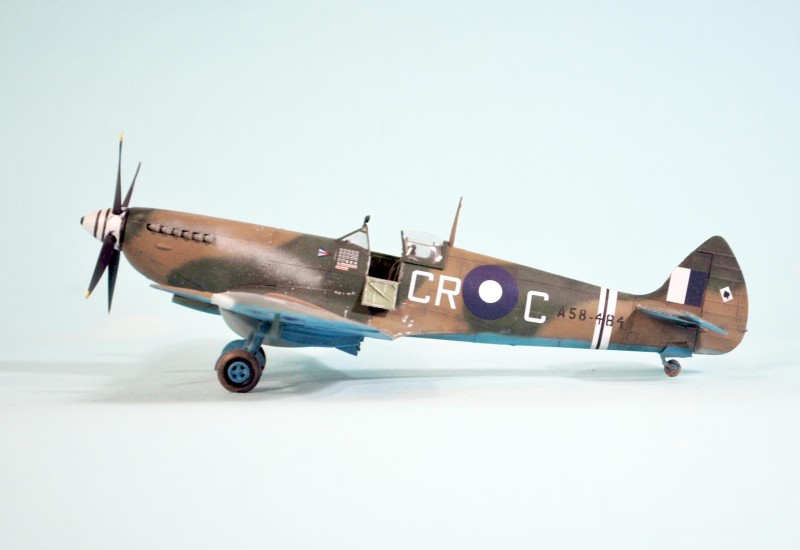
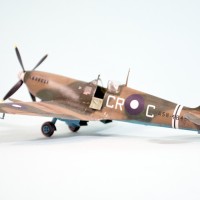
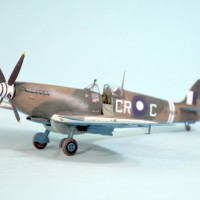
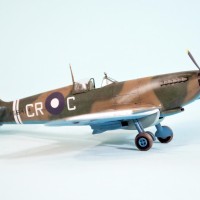
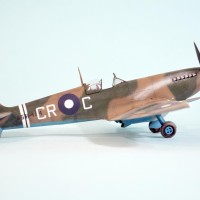
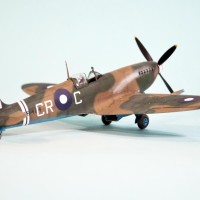
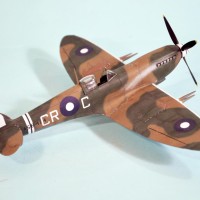
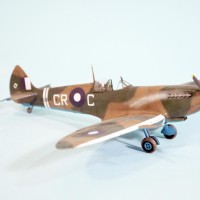
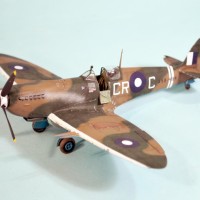
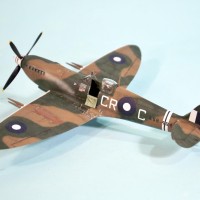

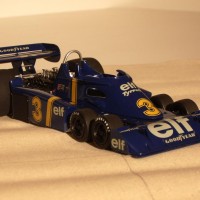
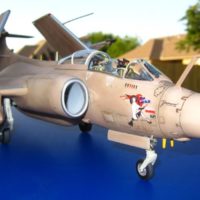
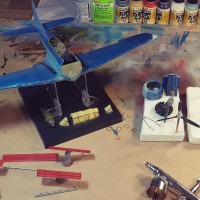
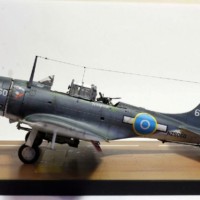
A superb build, Tom! I love Spitfires and I love Aussie schemes, so what better than Spit in Aussie markings; a simply irresistible sight. The foliage green looks really nice by the RAF dark earth, a really exciting camo.
A great article, as well (and as usual).
This is an awesome build, Tom @tcinla
Thanks for sharing the building process as well.
Maybe I missed it somewhere in the information, but what is the grey box underneath the Spit?
Is this an additiona fuel tank.
@johnb - yes, a "slipper tank" - 108 gallons.
@tcinla, thanks a lot for the explenation Tom. Another learning moment.
Nice work on this one as usual, Tom. I never realized that plane had four cannons.
It was only for a short period.
Nice work Tom
May I ask you the mix you used for the dark Earth and Green?
Thanks
The Dark Green is Tamiya "Deep Green" with a little bit of their "Black Green." The Dark Earth is a combination of their "Khaki," "Flat Earth," "Red" and "Yellow." Mixed to match the color of Xtracrylix Dark Earth, which is accurate.
Thanks
Another great write-up and build, Tom. And Spitfires are ALWAYS welcome!
Great work with that Passche-H airbrush.
Once again, a superb build. The Aussies gave so much to the Empire in two World Wars that I'm glad the RAF let them have their squadrons back for home defense. I don't know it is true or just "hangar talk" but I heard that the early Spits had engine cooling issues when they first got down under because the Merlin cooling system was optimized for the more temperate climes of the Continent.
Lastly, I love your "tips/shortcuts" on how to de-bug the instructions for a kit.
Yeah, instructions aren't just "somebody's opinion," but they're also not written on stone tablets.
Yup…the only instructions I have found that were pretty much written in stone were those for the Accurate Miniatures SBD series kits. You can ignore them, but at your peril.
Also the Accurate Miniatures Avenger and F3F. Bill's the kind of guy who made sure the instructions were right.
Looks great, Tom (@tcinla). Australian planes are just different enough to make them look totally different. Paint and weathering look awesome.
Fantastic Spitfire! This version didn't have 0,303 machine guns in wings? Only 4x Hispano?
Correct. The only other Spitfires to do this were 2 Squadron SAAF in Italy. As with this, the cannon armament was for ground attack, not A2A combat.
I remember some photos from Operation Calendar (transport planes for Malta defence). Some Spitfires Vc had 4x Hispano.
https://weaponsandwarfare.files.wordpress.com/2016/06/life-features_01_temp-1431430420-5551e514-620x348.jpg
They were bringing spares. Once on Malta, they removed the two cannons and often also the machine guns to lighten the planes for combat. No Spitfires used 4 cannons for aerial combat till the Spitfire 21 arrived.
Very interesting information! Thank You!
Really sharp work Tom. I've always liked Caldwell's markings.
That's really nice Tom @tcinla ! Love the history too, as usual. ? ?
Spitfire with code CR@C was also in Vc version?
https://www.aviationmegastore.com/boring-old-silver---spitfire-mkvc-various-raaf-red-roo-rrd7235-scale-modelling/product/?action=prodinfo&art=83063
Caldwell was a wing leader and got to use his initials.
Very nice looking Spitfire, nice job on the build. Great read on the history and the paint scheme.
Excellent work Tom! Thank you for the history as well.
A right-nice looking Spit! Love the Pacific theater schemes. Well done.
So If I try build mark VIII Spit in Foliage Green, and SKy Blue camo, under green paint I need to mark old desert camo?